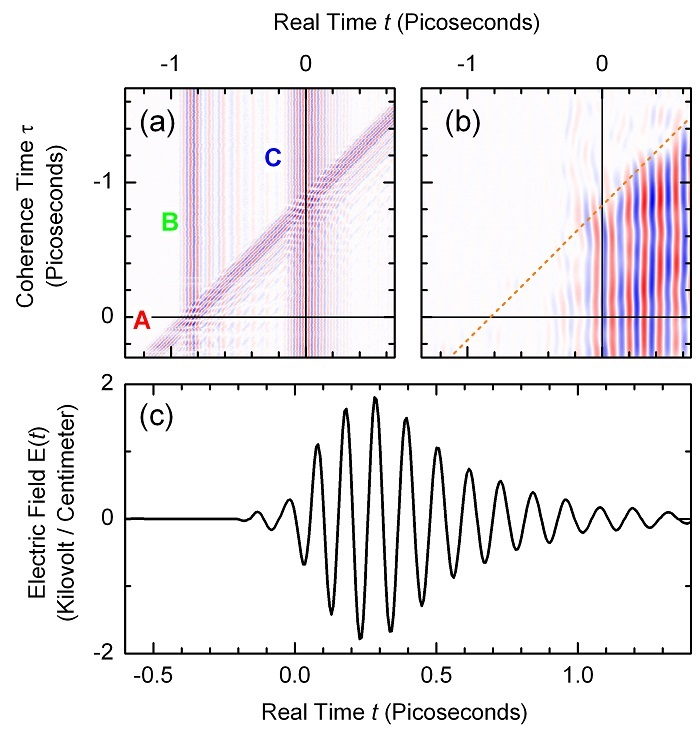28 April 2016
Two-quantum oscillations of atoms in a semiconductor crystal are excited by ultrashort terahertz pulses. The terahertz waves radiated from the moving atoms are analyzed by a novel time-resolving method and demonstrate the non-classical character of large-amplitude atomic motions.
The classical pendulum of a clock swings forth and back with a well-defined elongation and velocity at any instant in time. During this motion, the total energy is constant and depends on the initial elongation which can be chosen arbitrarily. Oscillators in the quantum world of atoms and molecules behave quite differently: their energy has discrete values corresponding to different quantum states. The location of the atom in a single quantum state of the oscillator is described by a time-independent wavefunction, meaning that there are no oscillations.
Oscillations in the quantum world require a superposition of different quantum states, a so-called coherence or wavepacket. The superposition of two quantum states, a one-phonon coherence, results in an atomic motion close to the classical pendulum. Much more interesting are two-phonon coherences, a genuinely non-classical excitation for which the atom is at two different positions simultaneously. Its velocity is nonclassical, meaning that the atom moves at the same time both to the right and to the left as shown in the movie. Such motions exist for very short times only as the well-defined superposition of quantum states decays by so-called decoherence within a few picoseconds (1 picosecond = 10-12s). Two-phonon coherences are highly relevant in the new research area of quantum phononics where tailored atomic motions such as squeezed and/or entangled phonons are investigated.
In a recent issue of Physical Review Letters, researchers from the Max Born Institute in Berlin apply a novel method of two-dimensional terahertz (2D-THz) spectroscopy for generating and analyzing non-classical two-phonon coherences with huge spatial amplitudes. In their experiments, a sequence of three phase-locked THz pulses interacts with a 70-μm thick crystal of the semiconductor InSb and the electric field radiated by the moving atoms serves as a probe for mapping the phonons in real-time. Two-dimensional scans in which the time delay between the three THz pulses is varied, display strong two-phonon signals and reveal their temporal signature [Fig. 1]. A detailed theoretical analysis shows that multiple nonlinear interactions of all three THz pulses with the InSb crystal generate strong two-phonon excitations.
This novel experimental scheme allows for the first time to kick off and detect large amplitude two-quantum coherences of lattice vibrations in a crystal. All experimental observations are in excellent agreement with theoretical calculations. This new type of 2D THz spectroscopy paves the way towards generating, analyzing, and manipulating other low-energy excitations in solids such as magnons and transitions between ground and excited states of excitons and impurities with multiple-pulse sequences.
Original publication: Physical Review Letters 116, 177401
Two-Phonon Quantum Coherences in Indium Antimonide Studied by Nonlinear Two-Dimensional Terahertz Spectroscopy
Carmine Somma, Giulia Folpini, Klaus Reimann, Michael Woerner, and Thomas Elsaesser
An additional article with the focus on the experimental technique has been published as well in:
The Journal of Chemical Physics 144, 184202
Phase-resolved two-dimensional terahertz spectroscopy including off-resonant interactions beyond the χ(3) limit
Carmine Somma, Giulia Folpini, Klaus Reimann, Michael Woerner, and Thomas Elsaesser















